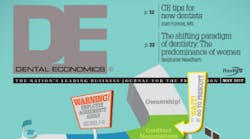Independent dentistry: the new approach
The November and December 2016 issues of Dental Economics contain articles that are particularly meaningful to traditional independent dental practitioners.(1,2) These articles discuss how external influences on daily practice have grown through the years, placing significant pressure on the healthy existence of private practices. This article will look at how we can respond and take a new approach to independent dentistry.
The dream
When we applied for admission to a dental school program, we had a dream. We envisioned taking risks, making decisions, and reaping our rewards.(3) Between 2012 and 2017, the number of offices controlled by multilocation dental groups jumped 25%.(4) Students currently graduating find their dream remote or unachievable. Their vision evaporates and many believe that practicing as an employee is the only option. Factors contributing to the demise of the dream include strict lending parameters, lack of business training, fear of going it alone, and concern over adding to student debt.
Insurance
A recent survey by Dental Products Report reveals that the most stressful issue in practice is dealing with insurance.(5) Approximately 80% of practice income dollars are derived from insured patients and insurance billings. PPO growth is significant and casts a huge shadow over indemnity insurance, which some predict will disappear in five to seven years. Just as antitrust regulations limit our ability to discuss UCR fees with one another, discussing insurance schedules is also a violation of the very contract we sign as participating providers. Our ability to knowingly deal with insurance carriers is severely limited.
As outlined by the American Dental Association regarding the dos and don’ts of antitrust, there are two methods where independent dentists can work together with insurance companies.(6) One of those is using the Messenger Model, and the other is participating in an Independent Practice Association (IPA). Though these are doable, they require very specific guidelines, and they’re very different. The Messenger Model does not require financial or business integration like an IPA.(7) Conversely, the Messenger Model requires strict obedience to guidelines related to sharing of information from one practice to another.(6)
Through either of these methods, dentists can attempt to work directly with insurance companies in the hopes of generating improved fees. Through a cooperative effort, individual practices can experience monthly collection increases in the thousands of dollars.
Practice overhead
An attempt to negotiate lower overhead (manufacturers, supply companies, dental laboratories, service vendors, etc.) is virtually useless. Individually we have a small financial footprint and our voice is not heard. It is a very difficult challenge. Though the concept of obtaining economies of scale is possible in a group setting, it may come at the cost of losing autonomy in purchase options. However, through a collective effort of likeminded dentists, I have seen in my experience that it is possible to negotiate purchase arrangements with manufacturers as well as distributors that reach discount levels reflecting 15%–65% savings.
Credit card processing
Dentists seldom understand the buried fees in their monthly credit card statements. This lack of transparency is often by design. More often than not, local banks are charging far more than market prices for credit card transactions. Merchant services group negotiations can lead to a significant savings in the cost of credit card use. By reducing or eliminating hidden costs, it’s possible to lower the effective rate from 3%–5% to under 2%. This reduction can result in savings of thousands. Hard dollar savings is just the beginning. Automatic recurring payments, wallet database, robust reporting, and website online payment add patient convenience, maximize office staff efficiency, and shorten the collection cycle. The soft dollar savings from these efficiencies often exceed the hard dollar savings.
Financial needs
It is surprising that dealings in the financial world can be positively affected. Lending institutions invest heavily in marketing and search for opportunities to lend to independent dentists. These internal costs result in higher fees and rates that are passed on to the borrower. When banks work directly with cooperative groups that create a “pipeline” of referrals, it is possible to have preferential financing with great terms for practice purchase and expansion, debt consolidation, and equity loans.
Current solution
We can engage outside experts to help us deal with each of these challenges. The expense of contracting with separate companies to provide each of these services can be collectively almost prohibitive. It becomes administratively demanding and is frequently without the collective effect.
The better solution
With the combined efforts of a group, either through the formation of an IPA or a Messenger Model, these concerns can be addressed. Experience tells us that we can remain independent, yet enjoy the same economies of scale as large group and corporate practices. By uniting and working together, we can accomplish what we cannot do individually.
It’s possible to (1) reduce supply expenses significantly, (2) maximize negotiations with insurance carriers, (3) increase PPO insurance fee schedules, (4) reduce credit card processing fees, and (5) minimize debt service by improving loan terms.
We should not sit by and watch our treasured profession erode around us. We should be proactive and get involved! By organizing, we can empower the independent office to be competitive. Working smart and together, we can preserve and achieve the dream.
References
1. Salierno C. The evolution of a cottage industry. Dental Economics. 2016;106(12):10.
2. Shah-Khan M. Why are private equity and venture capital groups interested in dental practice? Dental Economics. 2016;106(12):14-16.
3. Trends from the ADEA survey of dental school Seniors. American Dental Education Association website. http://www.adea.org/data/seniors. Published 2011. Accessed March 20, 2017.
4. Economic census (2012, 2007, 2002). United States Census Bureau website. https://www.census.gov/data/developers/data-sets/economic-census.html. Published September 15, 2016. Accessed March 20, 2017.
5. Duncan T. 5 insurance actions you can take now for a smooth 2016. Dental Products Report website. http://www.dentalproductsreport.com/dental/article/5-insurance-actions-you-can-take-now-smooth-2016. Published December 28, 2015. Accessed March 20, 2017.
6. The antitrust laws in dentistry: a primer of “dos, don’ts and how Tos” for Dentists and Dental Societies. American Dental Association website. https://www.sfds.org/fileLibrary/file_135.pdf. Published 2007. Accessed March 20, 2017.
7. US Department of Justice and the Federal Trade Commission. Statements of antitrust enforcement policy in health care, August 1966. Federal Trade Commission website. https://www.ftc.gov/sites/default/files/attachments/competition-policy-guidance/statements_of_antitrust_enforcement_policy_in_health_care_august_1996.pdf. Accessed March 20, 2017.
Steven L. Peacock, DDS, is a 1973 graduate of the University of Southern California and a founding member of the Dental Cooperative. Founded in 1998, the Dental Cooperative is the largest and oldest cooperative of independent dentists in the nation and is an example of the “Messenger Model.” Dr. Peacock can be reached at [email protected]">href="mailto:[email protected]">[email protected] or (702) 538-4633.

